The Suzuki Wagon R is a city car manufactured and marketed by Suzuki Motor Corporation since 1993. Often people think the R in Wagon R stands for racing but it’s not, The R in the name stands for Revolution and Relaxation.
The Wagon R uses a “tall wagon” configuration to maximize cabin space within city car dimensional restrictions for Japan.
The Wagon R has been the best-selling city car in Japan since 2003. In 2008, Suzuki produced its three-millionth Wagon Rs .Sales reached 5 million at the end of February 2010.
Contents
1. First generation (CT21S/CT51S/CV21S/CV51S; 1993–1998)
2. Second generation (MC21S/MC11S/MC22S/MC12S; 1998–2003)
3. Third generation (MH21S/MH22S; 2003–2008)
4. Fourth generation (MH23S; 2008–2012)
5. Fifth generation (MH34S/MH44S; 2012–2017)
6. Sixth generation (MH35S/MH55S; 2017–present)
7. Wagon R-Wide
First generation (CT21S/CT51S/CV21S/CV51S; 1993–1998)
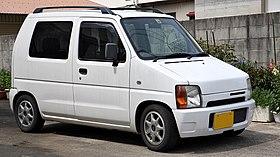
| First generation (CT21S/CT51S/CV21S/CV51S) | |
| First generation Wagon R (right-hand side) | |
| Overview | |
| Also called | Autozam AZ Wagon
Mazda AZ Wagon |
| Production | September 1993 – October 1998 |
| Body and chassis | |
| Body style | 3/5-door hatchback |
| Powertrain | |
| Engine |
|
| Transmission | 3-speed automatic
4-speed automatic 5-speed manual |
| Dimensions | |
| Wheelbase | 2,335 mm (91.9 in) |
| Length | 3,295 mm (129.7 in) |
| Width | 1,395 mm (54.9 in) |
| Height | 1,640–1,695 mm (64.6–66.7 in) |
| Curb weight | 720–820 kg (1,587–1,808 lb) |
The first generation Wagon R is 1,640 mm (64.6 in) high, or 255 mm (10.0 in) taller (170 mm (6.7 in) internally) than the JDM Suzuki Alto sold at the same time (which was exactly the same length and width).
Like the Alto and other Suzuki key cars, it used the R660cc F6A three-cylinder engine.
Originally introduced at the 1993 Tokyo Motor Show, it has two doors on the left and a single door on the right (driver’s). The most common, symmetrical five-door layout became available in August 1996 and quickly replaced the previous body style. For the 1994 Model Year, it won the Japan Automobile Researchers and Journalists’ Conference Car Award.
The redesigned Automotive Z-Wagon was introduced in September 1994. Using the F6A engine, the model was marketed through Mazda’s Autosom network as part of an OEM deal. After April 1997, it was sold as the “Mazda Z-Wagon”.
The big first generation Wagon R, Suzuki Wagon R + was assembled in early 1997 and manufactured in Japan for the European market until the late 2000s.
The car had a wider body and the naturally anticipated K10A engine was a 996cc and four-cylinder.The same Wagon R+ was also available with a 1.2 liter K12A engine.
Second generation (MC21S/MC11S/MC22S/MC12S; 1998–2003)
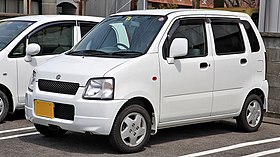
| Second generation (MC21S/MC11S/MC22S/MC12S) | |
| Suzuki Wagon R (pre-facelift) | |
| Overview | |
| Also called | Mazda AZ Wagon |
| Production | October 1998 – September 2003 |
| Body and chassis | |
| Body style | 4/5-door hatchback |
| Powertrain | |
| Engine |
|
| Transmission | CVT
3-speed automatic 4-speed automatic 5-speed manual |
| Dimensions | |
| Wheelbase | 2,360 mm (92.9 in) |
| Length | 3,395 mm (133.7 in) |
| Width | 1,475 mm (58.1 in) |
| Height | 1,640–1,685 mm (64.6–66.3 in) |
| Curb weight | 730–900 kg (1,609–1,984 lb) |
The second generation Wagon R was introduced in Japan in 1998 and the Wagon R + was redesigned and replaced in 1999 – it was brought to Europe in 2000 with larger engines (see Wagon R-Wide).This large version is produced by Margar Suzuki in Esther, Hungary and Maruti Suzuki in Gurgaon, India. Opal Aguila is the logo of the Suzuki Wagon R +, introduced in the summer of 2000. The Maruti Suzuki Wagon R generation was manufactured in India until 2010.
Third generation (MH21S/MH22S; 2003–2008)
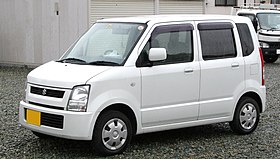
| Third generation (MH21S/MH22S) | |
| 2003–2005 Suzuki Wagon R (pre-facelift) | |
| Overview | |
| Also called | Mazda AZ Wagon |
| Production | September 2003 – September 2008 |
| Body and chassis | |
| Body style | 5-door hatchback |
| Powertrain | |
| Engine |
|
| Transmission | CVT
4-speed automatic 5-speed manual |
| Dimensions | |
| Wheelbase | 2,360 mm (92.9 in) |
| Length | 3,395 mm (133.7 in) |
| Width | 1,475 mm (58.1 in) |
| Height | 1,635–1,655 mm (64.4–65.2 in) |
| Curb weight | 810–940 kg (1,786–2,072 lb) |
The third generation Wagon R was launched in Japan in September 2003 to mark the tenth anniversary of the Wagon R, but is now only available as a key car with a 660cc K6A engine – not an expanded version (like the previous wide and + versions). The third generation was replaced in September 2005, three years after the encounter.
The Stingray, first seen in February 2007, is a sportier version of the third generation Suzuki Wagon R.The name is a tribute to “Stingray” Fronte, who was introduced in the 1970s.
In addition to a more aggressive front end treatment, the Stingray also received clear taillights.
Alloy wheels and an air kit were also adopted.The 660cc engine is powered by a turbocharger, which further increases speed and acceleration.
On average, the Stingray went from 0 km/h (0 mph) to 100 km/h (62 mph) in about 15 seconds.
Fourth generation (MH23S; 2008–2012)
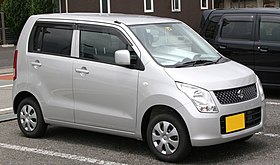
| Fourth generation (MH23S) | |
| Fourth generation Suzuki Wagon R | |
| Overview | |
| Also called | Mazda AZ Wagon |
| Production | September 2008 – November 2012 |
| Body and chassis | |
| Body style | 5-door hatchback |
| Powertrain | |
| Engine |
|
| Transmission | CVT
4-speed automatic 5-speed manual |
| Dimensions | |
| Wheelbase | 2,400 mm (94.5 in) |
| Length | 3,395 mm (133.7 in) |
| Width | 1,475 mm (58.1 in) |
| Height | 1,660–1,675 mm (65.4–65.9 in) |
| Curb weight | 800–930 kg (1,764–2,050 lb) |
The fourth generation Wagon R was launched in Japan in September 2008, with the Sportier Stingray, the Z-Wagon and the Z-Wagon Custom variant (both made for Mazda).
Consisting of larger rear doors, which feature incorporate quarter glass,eliminating the need for a D-tower layout are the significant changes that took place in new generation.
Powertrain options include naturally aspirated and turbocharged 660 cc engines with the latter developing an output of 64 PS (47 kW), mated to a 4-speed automatic, a 5-speed manual transmission or a CVT. As with many other Japanese market models, customers can choose between front-wheel and all-wheel-drive versions.
Fifth generation (MH34S/MH44S; 2012–2017)
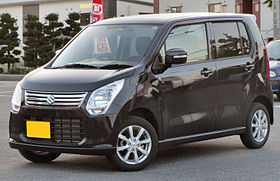
| Fifth generation (MH34S/MH44S) | |
| Suzuki Wagon R FX Limited (pre-facelift) | |
| Overview | |
| Also called | Mazda Flair |
| Production | September 2012 – January 2017 |
| Body and chassis | |
| Body style | 5-door hatchback |
| Powertrain | |
| Engine |
|
| Electric motor | WA04A |
| Transmission | CVT
5-speed manual |
| Dimensions | |
| Wheelbase | 2,425 mm (95.5 in) |
| Length | 3,395 mm (133.7 in) |
| Width | 1,475 mm (58.1 in) |
| Height | 1,640–1,660 mm (64.6–65.4 in) |
| Curb weight | 780–870 kg (1,720–1,918 lb) |
In September 2012, the fifth generation Wagon R range was launched in Japan.
It was marketed as “ENE-CHARGE” with an alternative soft hybrid system and as “ECO-COOL” with an energy saving electric air conditioning system.
The R06A engine, combined with an electric motor / generator and a lithium-ion battery, provides the internal combustion engine with renewable brakes and power, and can run some electrical equipment at speeds of up to 28.8 km / h. JC08 race cycle in Japan (US 67.8 mpg, 3.5 l / 100 km EU or 81.4 mpg UK).
Flare and Flare Custom style were launched in October 2012.For the Mazda variants, the fifth generation Wagon R models are marketed as the Mazda Flare, while the Stingray models are redesigned as the Mazda Flare custom style.
Sixth generation (MH35S/MH55S; 2017–present)
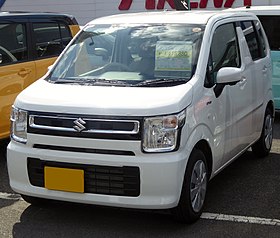
| Sixth generation (MH35S/MH55S) | |
| Suzuki Wagon R Hybrid FX | |
| Overview | |
| Also called | Mazda Flair |
| Production | January 2017 – present |
| Body and chassis | |
| Body style | 5-door hatchback |
| Platform | HEARTECT platform |
| Powertrain | |
| Engine |
|
| Electric motor | WA05A
WA05C |
| Transmission | CVT
5-speed manual |
| Dimensions | |
| Wheelbase | 2,460 mm (96.9 in) |
| Length | 3,395 mm (133.7 in) |
| Width | 1,475 mm (58.1 in) |
| Height | 1,650 mm (65.0 in) |
| Curb weight | 730–850 kg (1,609–1,874 lb) |
In Japan on 1 February 2017, the sixth generation Wagon R range was manufactured.
The new Wagon R leaked to the internet in January 2017.The new model is closely similar to the first, second and third generation Wagon R, but with a more up-to-date design.
The process comes with more capacity for the upgraded ISG (integrated starter generator) and hybrid battery.
Therefore it is possible to run the Wagon R alone on its hybrid battery, for up to 10 seconds if the speed is kept below 13 kilometers per hour (8 miles per hour).
Wagon R-Wide
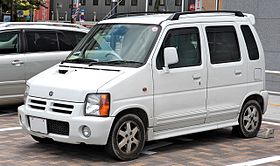
| Wagon R-Wide (MA61S/MB61S) | |
| Suzuki Wagon R-Wide (pre-facelift, Japan) | |
| Overview | |
| Also called |
|
| Production |
|
| Assembly | Sagara Plant, Shizuoka Prefecture, Japan
Jiangxi, China Bogotá, Colombia Bekasi Regency, Indonesia |
| Body and chassis | |
| Class | City car/Mini MPV |
| Body style | 5-door hatchback |
| Layout | Front-engine, front-wheel-drive or four-wheel-drive |
| Powertrain | |
| Engine |
|
| Transmission | 4-speed automatic
5-speed manual |
| Dimensions | |
| Wheelbase | 2,355 mm (92.7 in) |
| Length | 3,400–3,470 mm (133.9–136.6 in) |
| Width | 1,575 mm (62.0 in) |
| Height | 1,670–1,705 mm (65.7–67.1 in) |
| Curb weight | 810–880 kg (1,786–1,940 lb) |
| Chronology | |
| Successor | Suzuki Wagon R Solio/Solio |
Next the Wagon R-Wide came in February 1997.
This is a fairly large car that exceeds the key car specifications with larger engines:996cc (K10A, 48 kW/88Nm), 996cc Turbo (JDM, New Zealand and Australia only, K10A, 73 kW/118Nm) and 1.2-litre (K12A, 51 kW/93Nm) engine.
Wagon R-Wide was sold in the European market as the Wagon R + (introduced the same year) with atmospheric versions of the 1.0 K10A and the 1.2 K12A.
At the time of its introduction, the Daihatsu Move was the only tall wagon-style car sold in Europe. The car is made in Japan.
It was not galvanized and after years of use in Central and Northern Europe it was prone to rust.
Wagon R-Wide came face to face in May 1998 and this updated Wagon R-Wide was sold in Europe under Wagon R +. The first generation in Europe was sold from 1997 to May 2000.
Between 1999 and 2001, it was also built in Colombia by GM Colmotores, who sold it as the Chevrolet Wagon R+. This naturally-looking K10A four-cylinder engine.
In Indonesia, the first generation Japanese wagon R-Wide was sold as the Suzuki Karimun, manufactured locally from 1999 to 2006 and offered with a 1.0-liter petrol engine, which in China is the basis for Cheng’s Bedoxing.
The Big Dipper is based on the old F10A with a locally made 1.0-liter engine or the more modern 1.4-liter K14Bengine.
The successor to the Wagon R-Wide is the Solio, originally named Wagon R Solio in Japan.